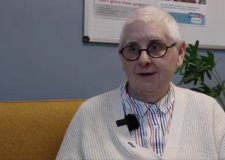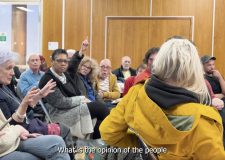A New Dawn at St Peter’s
Frank le Duc reports on the turnaround in fortunes of St Peter’s Church since it was saved from closure

St Peter’s Church stands at the gateway to Brighton. It is an icon but just a few short years ago its future was in doubt. The Church of England looked likely to make St Peter’s redundant. This would have meant closure. The congregation had dwindled, the repair bills and running costs seemed unaffordable. A small local group mounted an effective campaign and, when all seemed lost, a London-based church offered to step in.
Holy Trinity Brompton took over St Peter’s, turning it into a “plant” or off-shoot. In the business world it would be considered a branch office. Since then – the first service was in November 2009 – the change in fortunes has been marked. The congregation is more youthful and noticeably more numerous. And while any good Christian will remind you that it’s not purely a numbers game – after all God will be present “where two or three are gathered in my name” – the numbers help when there is work to do and money to raise.
And numbers permit the kind of response seen when St Patrick’s, off Western Road, Hove, announced that it was closing its night shelter from the end of January. This month the church leadership has been looking back at one of the most high profile projects led by St Peter’s – the Brighton and Hove Churches Night Shelter. Eight local churches – Anglican and Catholic, traditional and evangelical – worked together to ensure that there were overnight beds in the warm and dry for 15 homeless people during one of the coldest spells of the year.
A SHELTER FOR THE HOMELESS
Becky Atkins, 26, a member of the congregation at St Peter’s, was the project co-ordinator. She said: “The first week was sub-zero and it must have been sub-zero for most of February. We had space for 15 people and over the two months we had 26 guys. Some were in for a few nights and then moved on to other things. We had quite a range.
“There was quite a mix of different people’s stories and quite a range of ages too. The youngest was probably 19 years old and the oldest was in his sixties. We had Eastern Europeans who were here looking for work and had come over here and some asylum-seekers. There were people who had missed rent payments and lost their home. We took the last four guests who had been in St Pat’s and hadn’t been allocated anywhere else.
“Something that’s been very good for the churches and the volunteers was that they didn’t know what to think and what to say to these guys. They’ve all got their stories and their situations. And it makes such a difference when you meet people face to face. I’m not very good with statistics.
“We held a training evening in January in the week before we opened and there were 275 volunteers. Some churches almost had to turn away volunteers because they had too many people. Some churches had a small core who helped every week. Other churches had a larger group who shared the load. It captured the imagination of the city. And it shows the impact you can have when you work together.”
A BIG SUCCESS
She said that some of the professional agencies were concerned about using a different church each night of the week and the scope for confusion, but Becky said that it sustained the incredible willingness. “People maintained a high level of enthusiasm because it was once a week. It’s never going to solve the problem. It’s about helping out in the worst weather. There’s talk about doing it for three months next year instead of two months. And it would be good to have a longer lead-in time.”
She said that there were some amazing conversations between the volunteers and their guests. “There was definitely a high level of banter. I went to a few places when they were having dinner and at times, unless you knew, you wouldn’t necessarily know who was a guest and who was a volunteer. When they had their last nights it was quite poignant as people said goodbye for the last time. One guy who was offered accommodation was told that he could have a night in a hotel before the accommodation was available but he wanted to spend that last night in one of the churches.
“Some of the volunteers have maintained contact with one or two of the guys. There was a sense of real care among the volunteers. They wanted to know what they’d been up to between each stay. You got to know these guys for who they are instead of just seeing them on the street and looking away and walking on by.
“By the grace of God it was a success. There was a fear that it was a church project and it would be a bit ad hoc. We did all the checks and made sure that they weren’t bringing in alcohol as much for their safety as for ours. There was a very loving environment and I think they really appreciated that.”
Drink, she said, was definitely an issue for many of Brighton and Hove’s rough sleepers. The job of the volunteers was to make sure that it wasn’t being brought into the churches and that everyone could stay in a safe space.
The churches worked with the council’s rough sleepers team, the Antifreeze project run by Off The Fence, with the YMCA and St John Ambulance. Homeless people couldn’t just turn up at the door. They were referred and assessed. First Base, run by Brighton Housing Trust, handled referrals. And the volunteers also worked with St Patrick’s where some rough sleepers still turn up.
In the past week Becky has been giving and receiving feedback with those agencies, the volunteers and church leaders. She said: “I think all the agencies in the city would like to see it next year. There’s nothing else. They’d probably like to see it run for longer than three months. All the relationships are established. It’s got the potential to be even more successful next year.”

PLACES TO STAY
•The churches taking part were;
•St Peter’s Church, York Place, Brighton
•The Church on the Rock, St James’s Street, Brighton
•The Church of Christ the King (CCK), New England Street, Brighton
•Sacred Heart, Norton Road, Hove
•St Joseph’s Church, Wellington Road, Brighton
•One Church, Gloucester Place, Brighton
•All Saints Church, The Drive, Hove
•St Andrew’s Old Church, Church Road, Hove
Each church looked after up to 15 homeless people one night a week on the same night each week. Sacred Heart took part during February with St Joseph’s taking over during March.
WHAT’S DIFFERENT?
Brighton was heavily populated with churches in the 19th century. The first census of the 21st century gave a strong impression that Brighton and Hove was the most secular city in the country. In a nod to Star Wars, the number of people declaring themselves to be Jedis was in part a student prank which went viral, but it reflected our city’s cheeky humour. In such a secular climate and with many congregations dwindling, it was not hard to see why the Church of England struggled to justify the cost of keeping so many churches in Brighton and Hove – and so many expensive churches at that.
The new ministry came in with a fresh optimism and a youthful zeal that has reached out to students and families, counterbalancing the predominantly ageing traditional church population. To give one example, St Peter’s attracted more than a thousand people to its three Christmas carol concerts. And it has earned comparisons with the Church of Christ the King, in New England Street near by, which grew out of the Clarendon and showed how popular a dynamic church could be.
One of the foundations of the new ministry in Brighton is the Alpha Course, devised by Nicky Gumbel, father of Jonny Gumbel, the curate at St Peter’s. The course is an introduction to Christianity, nurturing and challenging at the same time. But there is a business-like approach too at St Peter’s. The church leadership encourages people to be part of a team and it gives them a purpose. Even those who have no desire to join a church could learn from the turnaround seen at Brighton’s parish church.
RAISING THE ROOF
Old churches are often popular with people as an aesthetically pleasing feature of the urban landscape. But it’s much harder raising the funds to maintain buildings such as St Peter’s which is listed. It was consecrated in 1828 – the same year that the Royal Sussex County Hospital first opened. The original hospital building is known as the Barry Building after its architect Charles Barry. He also designed St Peter’s and went to design the Houses of Parliament.
Those charged with running the Church of England – and trying to fund the costs – are often quick to point out that a church is much less about a building and more about the congregation. The church can congregate anywhere. The grand symbolic buildings tend to be relics of a more powerful or influential past. Modern churches tend to be on a more modest, almost domestic scale.
When St Peter’s reopened in November 2009 the building was in need of significant repair. The new team – led by Archie Coates, supported by his wife Sam, curate Jonny Gumbel and others – have been busy raising funds, including a grant from English Heritage. Now the builders are in and the scaffolding is up as they try to make sure that the roof is safe and watertight. The first phase of building work is due to be completed this month.



















